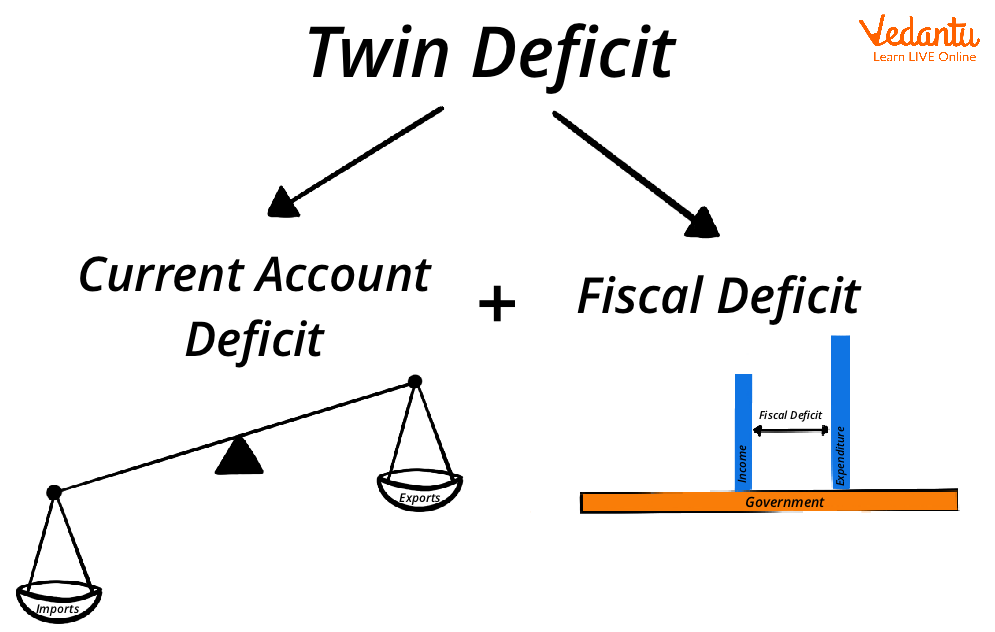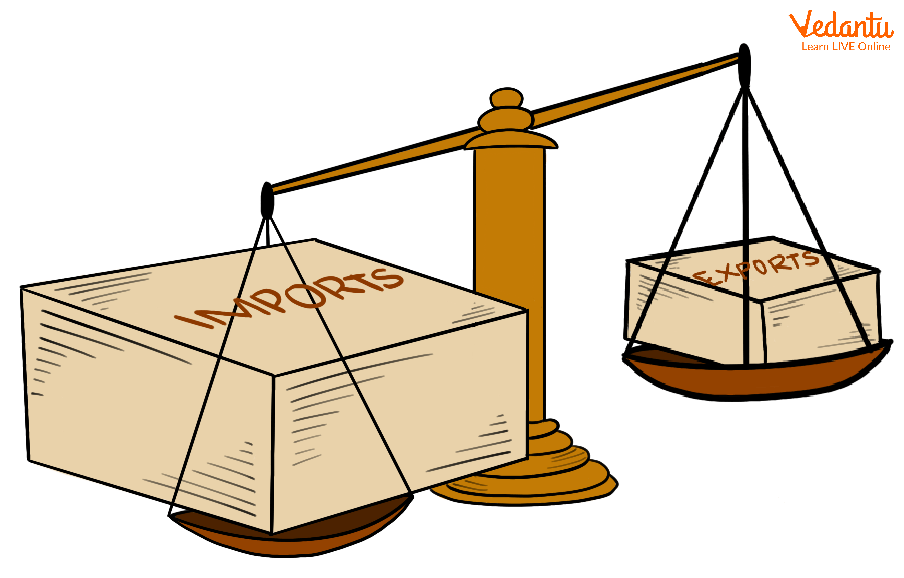




Twin Deficit - Combination of Fiscal and Current Account Deficit
Twin deficit refers to the situation when an economy suffers from both the fiscal deficit and the Current Account Deficit. It is a more common phenomenon in the United States. A twin deficit problem occurs when there is a simultaneous rise in both fiscal and current account deficits. A fiscal deficit occurs when expenditure is higher than income. A twin deficit is overcome when Fiscal Deficit is higher than the Current Account deficit and vice versa.
What is a Twin Deficit?
Fiscal Deficit and Current Account Deficit together are known as Twin Deficits. The opposite of these, fiscal surplus and current account surplus are considered the preferable situation for a nation's economy. The United States has faced this twin deficits problem for years, whereas China has been considered a nation with fiscal and current account surpluses.

Twin Deficit
Fiscal Deficit and Current Account Deficit
Fiscal Deficit - The First Twin
A fiscal deficit is referred to as a budget shortfall. A current Account Deficit occurs in an economy when the nation's imports exceed exports. A fiscal deficit, also called a budget deficit, is a situation which occurs when a nation is spending more than its revenues. Generally, a fiscal deficit is not considered good for an economy.

Fiscal Deficit Meaning
But in the opinion of Keynesian economists, deficit spending can be a significant measure in boosting a stagnant economy. Deficit spending results in the creation of aggregate demand, which is important for a healthy economy in a country. To fund this fiscal deficit, governments issue bonds in the market, which results in the injection of liquidity in the economy.
Current Account Deficit - The Second Twin
The current account shows a nation's trade and transactions with other nations. This account includes the difference between the value of goods and services exported and imported as well as net payments. When a nation's imports exceed its exports, it indicates that the country is giving a boost to another nation’s economy or it is spending more overseas.

Current Account Deficit
Difference between Current Account Deficit and Fiscal Deficit
There is a difference between Fiscal Deficit and Current Account Deficit. A fiscal deficit is defined as the difference between the total expenditure of the government and its total receipts, which does not include borrowings. The fiscal deficit can be financed in two ways, i.e., by borrowing from the Reserve Bank of India, known as deficit financing or money creation, and by market borrowing. Borrowing in an uncontrolled manner is not good for the economy. The fiscal deficits increasing over the years results in large debts and debt traps. A current Account Deficit arises when a country’s imports exceed its exports. This results in a deficit in the country’s trade account.
Deficit Theory
According to the views of some economists, a large fiscal deficit is associated with a large current account deficit. This theory of macroeconomics is known as the twin deficit theory. The deficit theory is based on the logic that when government tax cuts are increased, it reduces government revenues and thus increases the deficit. The consequence of these increased tax cuts is increased consumption by taxpayers as they spend the amount thus left from paying tax. This increased spending by the taxpayers reduces the savings rate, which finally leads to an increase in the amount received by the nation from abroad.
Twin Deficit Problem
The twin deficit problem simultaneously refers to an increased fiscal and current account deficit. The consequence of this twin deficit problem increases fiscal deficit, which may lead to the widening of the current account deficit.
Causes of Twin Deficit
The twin deficit is mainly a result of a simultaneous increase in Fiscal Deficit and Current Account Deficit. A fiscal deficit in a country arises due to higher expenditure than income. It might happen due to a cut in excise duties, which raises the fiscal deficit and increases the current account deficit. An increase in the fiscal deficit will widen the current account deficit in cases, leading to a twin deficit problem for the economy.
Summary
Twin deficit includes fiscal deficit and current account deficit. When a nation faces both these deficits, it is known to have a twin deficit problem. A fiscal deficit happens due to more spending than revenue, i.e., budget shortfall. A current account deficit occurs when a nation's imports exceed its exports, and the nation sends more money abroad. Both these deficits can be financed in different ways and measures taken by the government.
FAQs on Understanding the Twin Deficit
1. What is meant by the term 'twin deficit' in economics?
The twin deficit refers to a situation in which a country simultaneously experiences two separate deficits: a fiscal deficit and a current account deficit (CAD). This means the government is spending more than its revenue, and the country as a whole is importing more goods and services than it is exporting.
2. What is the core difference between a current account deficit and a trade deficit?
The main difference is that the trade deficit is only one component of the current account deficit.
- A trade deficit occurs when a country's imports of goods exceed its exports of goods.
- A current account deficit (CAD) is much broader. It includes the trade deficit, as well as the balance of trade in services and net transfer payments (like foreign aid and remittances).
3. How does a large fiscal deficit typically lead to a current account deficit?
A large fiscal deficit can lead to a current account deficit through a causal relationship known as the twin deficit hypothesis. When the government runs a high fiscal deficit, it often finances this by borrowing. This increases the demand for loanable funds, pushing up domestic interest rates. Higher interest rates attract foreign capital, which strengthens the domestic currency. A stronger currency makes exports more expensive for other countries and imports cheaper for domestic consumers, thus widening the current account deficit.
4. Why is a persistent twin deficit considered a significant concern for an economy?
A persistent twin deficit is a major concern because it signals fundamental imbalances in the economy. Key risks include:
- Increased Foreign Debt: A chronic current account deficit must be financed by borrowing from abroad, increasing the country's external debt.
- Currency Vulnerability: Heavy reliance on foreign capital makes the economy vulnerable. A sudden withdrawal of this capital can trigger a sharp depreciation of the currency and a financial crisis.
- Inflationary Pressure: High government spending (fiscal deficit) can fuel excessive demand, leading to inflation.
5. What are the common policy measures governments use to correct a twin deficit?
Governments use a two-pronged approach to correct a twin deficit, addressing both deficits simultaneously:
- To reduce the fiscal deficit (Contractionary Fiscal Policy): This involves reducing government spending, cutting subsidies, and increasing taxes to bring expenditure closer to revenue.
- To reduce the current account deficit: This includes implementing policies to boost exports (e.g., through incentives) and curb non-essential imports (e.g., through tariffs). Additionally, measures may be taken to encourage foreign direct investment (FDI) over volatile portfolio investment.
6. What is the twin deficit identity or formula in macroeconomics?
The twin deficit identity is an equation that shows the relationship between a country's savings, investment, and its deficits. The basic formula is: (S - I) = (G - T) + (X - M). Where:
- S = Private Savings
- I = Private Investment
- G = Government Spending
- T = Government Revenue (Taxes)
- X = Exports
- M = Imports























